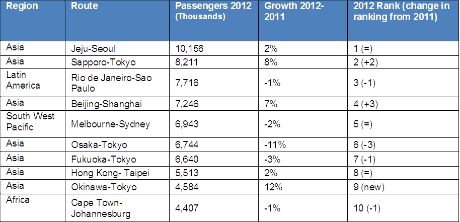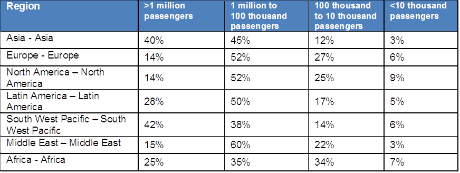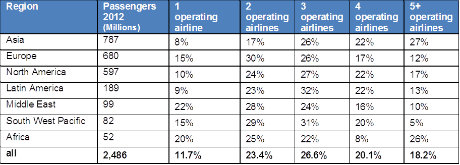- Each ‘super route’ carries over 1 million passengers per annum, according to the research.
- Air travel in 2012 was higher than 2011 in all regions of the world with significant growth of 9% in Asia and 6% in Latin America.
- Asia is the world’s most competitive aviation market with 75% of routes served by three or more airlines and just 25% of routes by one or two carriers.
- The Middle East is a rapidly growing hub as shown by traffic volume between Europe and Asia routed via the Middle East, growing by approximately 20% between 2011 and 2012.
- Low Cost Carrier penetration is highest in Europe at 38% and North America with 30%
Madrid, Spain, 2013-04-18 — /travelprnews.com/ — New analysis from Amadeus Air Traffic Travel Intelligence solution reveals that worldwide air traffic volume grew 5% between 2011 and 2012, with Asia being the largest, fastest-growing and most competitive market for air travel. The solution – which provides comprehensive passenger volume data, including both direct and indirect sales of airline seats – shows that Asia experienced year over year growth of 9% between 2011 and 2012, followed by Latin America, at 6%. The tool, part of the Amadeus’ Travel Intelligence portfolio, calculates the most accurate air passenger volume for any Origin and Destination (O&D) worldwide.
Among other key findings, the study reveals that 22% of all global air travel is concentrated on just 300 origin and destination ‘super routes ’, each of which carries over 1 million passengers annually. Furthermore, 69% of all global air travel is made on major routes with 100 thousand annual passengers.
In terms of connecting air traffic, the analysis shows the Middle East as a strong performer, with the three key airports of Doha, Abu Dhabi and Dubai all showing high connecting traffic volumes. For instance, when taken as a group the three airports now serve roughly 15% of all air traffic volume that goes from Asia to Europe and from Europe to the South West Pacific. Furthermore, Europe-Asia traffic routed via the Middle East is growing at roughly 20% per annum.
The analysis also shows Asia as the market with the highest airline competition, 75% of the region’s air traffic is operated by 3 or more airlines and 27% by five or more airlines, making this a region with a very intense competition in all its air travel routes.This contrasts sharply with other regions such as the Middle East and Europe where just half of all air traffic on its routes is operated by three or more airlines
Year over year passenger volume growth in air traffic, by region
Organised by greatest total passenger volume and measured in origin to destination journeys. Passengers travelling between regions are assigned to the region of origin.
The world’s busiest air routes by passenger volume are dominated by Asian domestic travel
Analysis of the busiest routes in the world by passenger volume shows that seven out of the top ten world’s busiest air travel routes are in Asia.
Jeju-Seoul in South Korea remains the world’s busiest air route, and many of 2011’s top origin and destination (O&D) routes return to the league table for 2012, however, there has been some change: in particular, Beijing-Shanghai has risen from seventh-busiest route in the world in 2011, to fourth-busiest in 2012. Sapporo-Tokyo has overtaken Rio de Janeiro-Sao Paulo to second-busiest route ranking, and Okinawa-Tokyo has entered the top ten table, as ninth-busiest route in the world.
Top 10 global air travel busiest routes by passenger volume
*Measured in origin to destination journeys travelled.
Global air travel is heavily concentrated, with 1000 worldwide origin and destination routes accounting for 40% of all global air traffic
35% of air travel in Europe and North America is made on smaller routes with fewer than 100 thousand annual passengers. This contrasts sharply with other regions such as Asia where 85% of air travel is concentrated on routes that carry over 100 thousand passengers each year.
This concentration of Asian air travel suggests the region’s growth may continue as there is an opportunity for airlines to develop secondary links beyond the heavily competitive super routes. In addition, the analysis shows that in Asia, the larger routes with over 100 thousand annual passengers have a 4%-9% growth range, but the smaller and medium sized routes in the region are growing at approximately 19%-21% per annum.
Global air travel concentration based on passenger volume for 2012
Competition within the airline industry has increased consistently
Globally, the airline industry has become consistently more competitive over the past three years. The percentage of air traffic served by just one or two airlines has fallen by 2% each year from 39% in 2010 to 35% in 2012. Concurrently, the percentage of air traffic with four or more competing airlines has also risen consistently from 35% in 2010 to 38% in 2012.
Asia is the market with the highest competition between airlines in the world, with 75% of air traffic volume served by more than 3 airlines and only 25% of air traffic served by one or two airlines.
Percentage of air traffic volume in each region with number of operating airlines
This contrasts strongly with other regions, for example in Europe 45% of air traffic volume is served by just one or two different airlines and in the Middle East 50% of all air traffic has only one or two competing carriers. The highly competitive nature of air travel in Asia may be due to the high concentration of passengers on a relatively low number of ‘super routes’, where several airlines vie for dominance.
Low Cost Carrier penetration is highest in the traditional European and North American markets
The rise of low cost airlines has been significant over the past decade, but this has been largely limited to traditional markets. Today, Europe has the highest concentration of LCC traffic, representing 38% of total air travel in 2012. The South West Pacific and North America regions also have significant LCC penetration, with 37% and 30% respectively. However, in markets where air travel is growing most strongly, LCCs’ respective share of overall air travel remains at modest levels – in the Middle East LCCs represent just 14% of all air travel, in Asia 19% and Latin America 25%.
LCC share of traffic in each region in 2011 and 2012
Passengers travelling between regions are assigned to the region of origin.
Within specific regions, the spread of LCCs varies strongly. In Europe, Spain has the highest share of departing LCC traffic at 57%, followed by the UK where 52% of all originating air travel is now made on low cost airlines, up 4% from 2011 and passing the 50% milestone for the first time. Despite the low overall share of low cost air travel in Asia, some countries have bucked this trend, for example 65% of all air travel in the Philippines and 61% of all air travel in Thailand is made on low cost carriers.
The Middle East is becoming an increasingly important global air travel hub
The region’s three key airports of Dubai, Doha and Abu Dhabi, are all experiencing strong overall air traffic growth of around 10% per annum and they have very high levels of connecting traffic, with each airport seeing around 50% of its total air travel volume connect. These figures demonstrate the region’s increasingly important role as a hub between Europe and the emerging markets of Asia and the South West Pacific.
When the three airports are taken as a group they already serve around 15% of air traffic volume between Asia – Europe and Europe – South West Pacific. It is particularly interesting to note that overall traffic volume between Europe and Asia is growing by approximately 7% year over year, but traffic volume between these two locations and routed via the Middle East grew by approximately 20% between 2011 and 2012.
Pascal Clement, Head of Travel Intelligence, Amadeus, commented: “The rapid pace of change and increasing competitiveness of the global airline industry, as evidenced by this data, means airlines and the wider travel industry increasingly need to base operational decision-making on data insights and analytics, in order to identify opportunities and risks as they emerge.”
He continued: “This data provides good news for the airline industry, showing that passenger air traffic has increased in every region of the world from 2011 to 2012. As in 2011, this growth is led by Asia, however, the data points to a further opportunity in the region, where the majority of traffic is on a small number of busy routes. The Amadeus Air Traffic solution helps airlines plan and develop networks that respond to true passenger traffic and meet a clear need in the market based on complete O&D data.”
– Ends –
See blog post on Amadeus Air Traffic Travel Intelligence:
http://www.amadeus.com/blog/16/04/travel-intelligence-in-the-digital-era-amadeus-air-traffic
Notes to the editors:
Amadeus is a leading provider of advanced technology solutions for the global travel industry. Customer groups include travel providers (e.g. airlines, hotels, rail and ferry operators, etc.), travel sellers (travel agencies and websites), and travel buyers (corporations and travel management companies).
The Amadeus group employs around 10,000 people worldwide, across central sites in Madrid (corporate headquarters), Nice (development) and Erding (operations), as well as 73 local Amadeus Commercial Organisations globally.
The group operates a transaction-based business model. For the year ended December 31, 2012 the company reported revenues of €2,910.3million and EBITDA of €1,107.7 million.
Amadeus is listed on the Spanish Stock Exchange under the symbol “AMS.MC” and is a component of the IBEX 35 index.
To find out more about Amadeus please visit www.amadeus.com
Contact details:
Amadeus
Corporate Communication
Telephone: +34 91 582 0160
Fax: +34 91 582 0188
Email: mediarelations@amadeus.com





